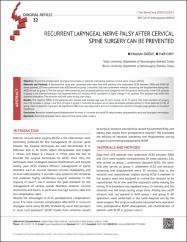Recurrent Laryngeal Nerve Palsy After Cervical Spine Surgery Can Be Prevented
Özet
Objective: To prevent postoperative laryngeal nerve palsy in patients undergoing anterior cervical spine surgery (ACSS). Materials and Methods: A retrospective study was conducted with data from 643 patients who underwent ACSS between 2006 and 2019. Of these patients, 125 who underwent only ACSS served as group I; the other 518, who underwent retractor loosening and displacement along with ACSS, served as group II. The two groups were compared, and paralyzed patients were compared with the general community. In the 518 patients in group II, the Cloward retractor was loosened every 15 minutes, which resulted in a slight change in its position. This protocol was unlike the standard procedure. The retractor was left loose during copy scopy. Results: The majority (58%) of the patients were female, and average age was 47 years (range: 24 to 75 years). The mean duration of surgery was 152 minutes in group I and 162 minutes in group II. Transient laryngeal nerve palsy developed postoperatively in three patients (2.4%) of group I but no patients in group II. No significant difference was observed in terms of surgical level, duration of surgery, age, gender, or comorbid conditions. Conclusion: Retractor loosening and displacement for every 15 minutes during ACSS helps prevent postoperative recurrent laryngeal nerve palsy.
Kaynak
Journal of Turkish Spinal SurgeryCilt
31Sayı
1Bağlantı
https://doi.org/10.4274/jtss.galenos.2020.41https://app.trdizin.gov.tr/makale/TXpZek1qTTJOZz09
https://hdl.handle.net/20.500.12900/44

















